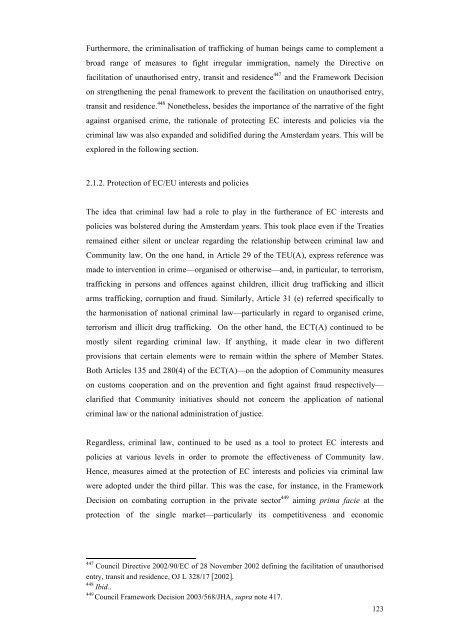The evolution of European Union criminal law (1957-2012)
The evolution of European Union criminal law (1957-2012)
The evolution of European Union criminal law (1957-2012)
You also want an ePaper? Increase the reach of your titles
YUMPU automatically turns print PDFs into web optimized ePapers that Google loves.
Furthermore, the <strong>criminal</strong>isation <strong>of</strong> trafficking <strong>of</strong> human beings came to complement a<br />
broad range <strong>of</strong> measures to fight irregular immigration, namely the Directive on<br />
facilitation <strong>of</strong> unauthorised entry, transit and residence 447 and the Framework Decision<br />
on strengthening the penal framework to prevent the facilitation on unauthorised entry,<br />
transit and residence. 448 Nonetheless, besides the importance <strong>of</strong> the narrative <strong>of</strong> the fight<br />
against organised crime, the rationale <strong>of</strong> protecting EC interests and policies via the<br />
<strong>criminal</strong> <strong>law</strong> was also expanded and solidified during the Amsterdam years. This will be<br />
explored in the following section.<br />
2.1.2. Protection <strong>of</strong> EC/EU interests and policies<br />
<strong>The</strong> idea that <strong>criminal</strong> <strong>law</strong> had a role to play in the furtherance <strong>of</strong> EC interests and<br />
policies was bolstered during the Amsterdam years. This took place even if the Treaties<br />
remained either silent or unclear regarding the relationship between <strong>criminal</strong> <strong>law</strong> and<br />
Community <strong>law</strong>. On the one hand, in Article 29 <strong>of</strong> the TEU(A), express reference was<br />
made to intervention in crime—organised or otherwise—and, in particular, to terrorism,<br />
trafficking in persons and <strong>of</strong>fences against children, illicit drug trafficking and illicit<br />
arms trafficking, corruption and fraud. Similarly, Article 31 (e) referred specifically to<br />
the harmonisation <strong>of</strong> national <strong>criminal</strong> <strong>law</strong>—particularly in regard to organised crime,<br />
terrorism and illicit drug trafficking. On the other hand, the ECT(A) continued to be<br />
mostly silent regarding <strong>criminal</strong> <strong>law</strong>. If anything, it made clear in two different<br />
provisions that certain elements were to remain within the sphere <strong>of</strong> Member States.<br />
Both Articles 135 and 280(4) <strong>of</strong> the ECT(A)—on the adoption <strong>of</strong> Community measures<br />
on customs cooperation and on the prevention and fight against fraud respectively—<br />
clarified that Community initiatives should not concern the application <strong>of</strong> national<br />
<strong>criminal</strong> <strong>law</strong> or the national administration <strong>of</strong> justice.<br />
Regardless, <strong>criminal</strong> <strong>law</strong>, continued to be used as a tool to protect EC interests and<br />
policies at various levels in order to promote the effectiveness <strong>of</strong> Community <strong>law</strong>.<br />
Hence, measures aimed at the protection <strong>of</strong> EC interests and policies via <strong>criminal</strong> <strong>law</strong><br />
were adopted under the third pillar. This was the case, for instance, in the Framework<br />
Decision on combating corruption in the private sector 449<br />
aiming prima facie at the<br />
protection <strong>of</strong> the single market—particularly its competitiveness and economic<br />
447 Council Directive 2002/90/EC <strong>of</strong> 28 November 2002 defining the facilitation <strong>of</strong> unauthorised<br />
entry, transit and residence, OJ L 328/17 [2002].<br />
448 Ibid..<br />
449<br />
Council Framework Decision 2003/568/JHA, supra note 417.<br />
123
















